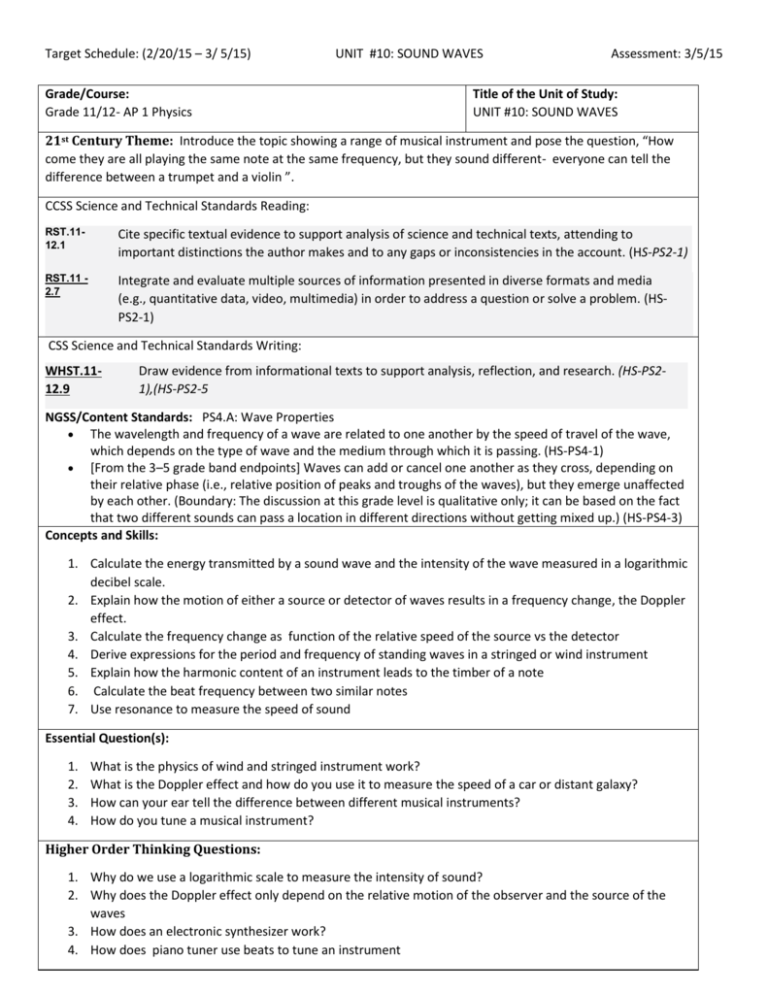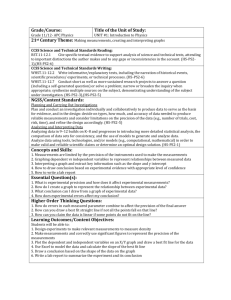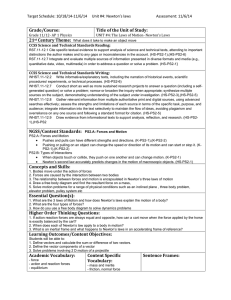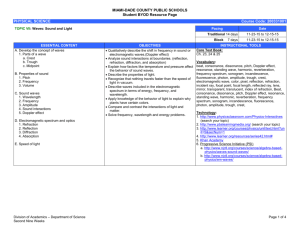Physics AP 1_UNIT #10- SOUND WAVES
advertisement

Target Schedule: (2/20/15 – 3/ 5/15) Grade/Course: Grade 11/12- AP 1 Physics UNIT #10: SOUND WAVES Assessment: 3/5/15 Title of the Unit of Study: UNIT #10: SOUND WAVES 21st Century Theme: Introduce the topic showing a range of musical instrument and pose the question, “How come they are all playing the same note at the same frequency, but they sound different- everyone can tell the difference between a trumpet and a violin ”. CCSS Science and Technical Standards Reading: RST.1112.1 Cite specific textual evidence to support analysis of science and technical texts, attending to important distinctions the author makes and to any gaps or inconsistencies in the account. (HS-PS2-1) RST.11 2.7 Integrate and evaluate multiple sources of information presented in diverse formats and media (e.g., quantitative data, video, multimedia) in order to address a question or solve a problem. (HSPS2-1) CSS Science and Technical Standards Writing: WHST.1112.9 Draw evidence from informational texts to support analysis, reflection, and research. (HS-PS21),(HS-PS2-5 NGSS/Content Standards: PS4.A: Wave Properties The wavelength and frequency of a wave are related to one another by the speed of travel of the wave, which depends on the type of wave and the medium through which it is passing. (HS-PS4-1) [From the 3–5 grade band endpoints] Waves can add or cancel one another as they cross, depending on their relative phase (i.e., relative position of peaks and troughs of the waves), but they emerge unaffected by each other. (Boundary: The discussion at this grade level is qualitative only; it can be based on the fact that two different sounds can pass a location in different directions without getting mixed up.) (HS-PS4-3) Concepts and Skills: 1. Calculate the energy transmitted by a sound wave and the intensity of the wave measured in a logarithmic decibel scale. 2. Explain how the motion of either a source or detector of waves results in a frequency change, the Doppler effect. 3. Calculate the frequency change as function of the relative speed of the source vs the detector 4. Derive expressions for the period and frequency of standing waves in a stringed or wind instrument 5. Explain how the harmonic content of an instrument leads to the timber of a note 6. Calculate the beat frequency between two similar notes 7. Use resonance to measure the speed of sound Essential Question(s): 1. 2. 3. 4. What is the physics of wind and stringed instrument work? What is the Doppler effect and how do you use it to measure the speed of a car or distant galaxy? How can your ear tell the difference between different musical instruments? How do you tune a musical instrument? Higher Order Thinking Questions: 1. Why do we use a logarithmic scale to measure the intensity of sound? 2. Why does the Doppler effect only depend on the relative motion of the observer and the source of the waves 3. How does an electronic synthesizer work? 4. How does piano tuner use beats to tune an instrument Target Schedule: (2/20/15 – 3/ 5/15) Learning Outcomes/Content Objectives: UNIT #10: SOUND WAVES Assessment: 3/5/15 1. Determine the speed of sound in air at one atmosphere of pressure at different temperatures. 2. Distinguish between the following terms: pitch, frequency, wavelength, sound intensity, loudness. 3. Determine intensity level in decibels of a sound if the intensity of the sound is given in W/m 2. 4. Explain how a standing wave can be produced in a wind instrument open at both ends or closed at one end and calculate the frequencies produced by different harmonics of pipes of a given length. 5. Determine the beat frequency produced by two tuning forks of different frequencies. 6. Explain how an interference pattern can be produced by two sources of sound of the same wavelength separated by a distance d. 7. Solve problems involving two sources for m, d, λ, and the angular separation (θ) when the other quantities are given. 8. Solve for the frequency of the sound heard by a listener and the wavelength of the sound between a source and the listener when the frequency of the sound produced by the source and the velocity of both the source and the listener are given. 9. Explain how a shock wave can be produced and what is meant by the term "sonic boom." Academic Vocabulary: - Content Specific Vocabulary: - Decibel - Intensity - Doppler effect - Resonance - Beats - Timber Sentence Frames: The softest sound we can hear is…….scale of loudness. The loudest sound we can tolerate is …. Police use the Doppler effect to measure … with…... Astronomers use the Doppler effect to measure…. Cardiologists use the Doppler effect to …….. in a ……. Labs/Demonstrations/Activities: 1. Speed of Sound lab 2. Standing wave demo 3. PHET waves 4. FENDT Java Simulations Resources: Web quiz: http://cwx.prenhall.com/bookbind/pubbooks/giancoli/chapter12/deluxe.html Simulations: http://www.walter-fendt.de/ph14e/ 1. Beats 2. Doppler Efffect https://phet.colorado.edu/sims/wave-on-a-string/wave-on-a-string_en.html https://phet.colorado.edu/en/simulation/wave-interference Video : https://ia600208.us.archive.org/2/items/AP_Physics_B_Lesson_45/Container.html https://ia600401.us.archive.org/17/items/AP_Physics_B_Lesson_32/Container.html https://ia600300.us.archive.org/4/items/AP_Physics_B_Lesson_46/Container.html https://ia700204.us.archive.org/18/items/AP_Physics_B_Lesson_47/Container.html Serway Faughn Vuille: College Physics Textbook Chapter 14 Target Schedule: (2/20/15 – 3/ 5/15) HAIKU PAGE: UNIT #10 UNIT #10: SOUND WAVES AP1 Physics Unit 10: SOUND WAVES (Chapter 14) Topic Reading 1. Sound SFV p(458-462) Summary p489 2. EnergyIntensity of Sound SFV p(463-466) 3. Doppler Effect SFV p(467-473) 4. Interference of Sound 5. Standing Waves 6. Resonance/ Standing Waves 7. Beats & Timber 8. Speed of Sound Lab SFV p(473-474) SFV p(475-479) SFV p(479- 484) SFV p(484- 489) 9. Review UNIT #10 Assessment: 3/5/15 Homework SFV p491: 1-7 SFV p491: 9-19 odd SFV p492: 21-29 odd SFV p493: 31,33 SFV p493: 35-41 odd SFV p491: 57-65 odd SFV p491: 49-53 odd Lab Report SFV p491: 1-19 odd WEB QUIZ10 10. Test Unit #10 VIDEO LECTURES: https://ia600208.us.archive.org/2/items/AP_Physics_B_Lesson_45/Container.html https://ia600401.us.archive.org/17/items/AP_Physics_B_Lesson_32/Container.html https://ia600300.us.archive.org/4/items/AP_Physics_B_Lesson_46/Container.html https://ia700204.us.archive.org/18/items/AP_Physics_B_Lesson_47/Container.html WEB QUIZZ10: http://cwx.prenhall.com/bookbind/pubbooks/giancoli/chapter12/deluxe.html In Class Work Unit Warm Ups Unit Notes – Focused Notes Class Participation Max Score 10 10 10 Score Target Schedule: (2/20/15 – 3/ 5/15) UNIT #10: SOUND WAVES Assessment: 3/5/15










